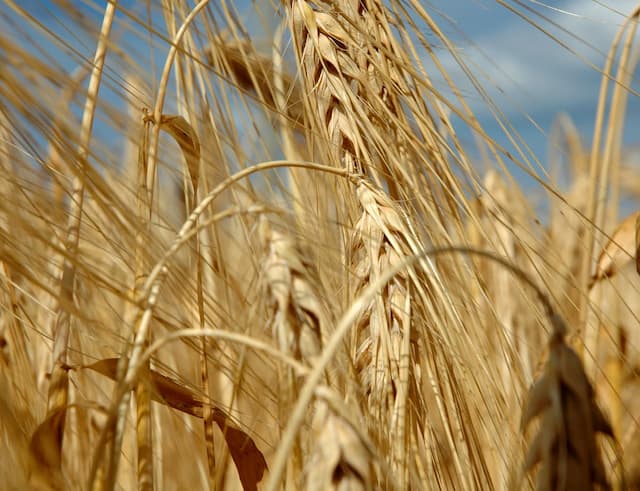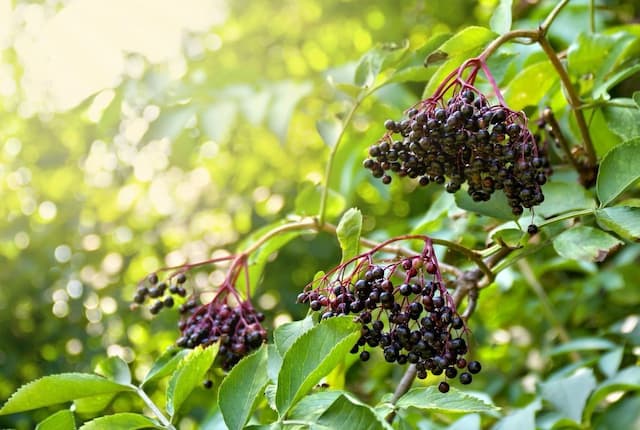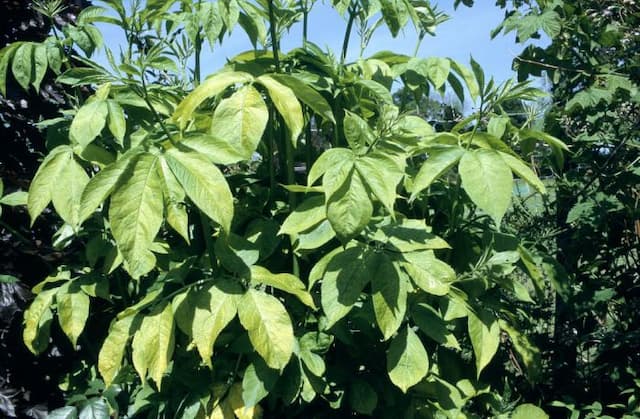Fragrant Viburnum Viburnum farreri

ABOUT
The plant commonly known as Fragrant Viburnum is a deciduous shrub with a rounded and bushy appearance. It is prized for its sweetly scented flowers which are pink in bud and open to a blush white. These flowers are small but abundant, forming dome-shaped clusters that bloom in winter or early spring, often before the leaves fully emerge. The leaves themselves are oval-shaped with coarsely toothed margins and typically take on a deep green color during the growing season, then change to reddish tones in autumn, adding to the plant's seasonal interest. In the fall, the Fragrant Viburnum may also bear fruit in the form of small, oval red berries that mature to black, providing food for birds and other wildlife.
About this plant
 Names
NamesSynonyms
Farrer's Viburnum, Fragrant Viburnum
Common names
Viburnum fragrans Bunge
 Toxicity
ToxicityTo humans
Farrer's viburnum is not commonly considered highly toxic to humans; however, it is often advised to avoid ingesting any part of ornamental plants due to the potential for mild stomach upset. If large quantities of plant material are ingested, symptoms may include vomiting, diarrhea, or abdominal pain, but serious poisoning is rare.
To pets
Similar to its effects on humans, Farrer's viburnum is not typically considered to be highly toxic to pets. However, ingestion of plant parts can still potentially cause mild gastrointestinal upset in animals, including symptoms such as vomiting and diarrhea. As with any ornamental plant, it is best to prevent pets from ingesting the plant to avoid any potential discomfort.
 Characteristics
CharacteristicsLife cycle
Perennials
Foliage type
Deciduous
Color of leaves
Green
Flower color
Pink
Height
6 feet (1.8 meters)
Spread
6 feet (1.8 meters)
Plant type
Shrub
Hardiness zones
4
Native area
China
Benefits
 General Benefits
General Benefits- Ornamental Appeal: Viburnum farreri, commonly known as the Fragrant Viburnum, offers a significant ornamental value with its showy, fragrant flowers and attractive foliage, enhancing the aesthetic of gardens and landscapes.
- Wildlife Habitat: The plant serves as a habitat and food source for various wildlife, including birds and pollinators, promoting biodiversity.
- Seasonal Interest: With flowers blooming in late winter to early spring, Fragrant Viburnum provides visual interest during a time when few other plants are in bloom.
- Drought Tolerance: Once established, the Fragrant Viburnum is relatively drought-tolerant, requiring minimal watering and reducing maintenance efforts.
- Ease of Cultivation: This plant is adaptable to a range of soil types and climates, making it relatively easy for gardeners of various skill levels to grow and maintain.
 Medical Properties
Medical PropertiesThis plant is not used for medical purposes.
 Air-purifying Qualities
Air-purifying QualitiesThis plant is not specifically known for air purifying qualities.
 Other Uses
Other Uses- Viburnum farreri, commonly known as Fragrant viburnum, can be used to create dense hedging for privacy in garden landscapes due to its bushy nature.
- When planted in groups or as a specimen plant, the Fragrant viburnum provides essential nesting sites for birds, offering shelter and protection.
- The plant's durable wood can be used in woodworking projects for creating small, carved objects or inlay work.
- Its dense foliage makes an excellent backdrop for highlighting other garden plants, enhancing the aesthetic appeal of a garden design.
- Fragrant viburnum branches are often cut and brought indoors for floral arrangements due to their pleasantly scented flowers and attractive form.
- The fibrous root system can help prevent soil erosion when planted on slopes or in other erosion-prone areas.
- In winter gardens, the Fragrant viburnum's persistent berries provide a splash of color when few other plants have fruit or flowers.
- The leaves of the viburnum can be used in crafting activities for children, such as leaf rubbing or printing.
- This plant can act as a natural windbreak when planted in a row, reducing wind speed in exposed areas.
- Fragrant viburnum's blossoms are a source of nectar for early foraging bees and other beneficial insects, supporting local biodiversity.
Interesting Facts
 Feng Shui
Feng ShuiThe Fragrant Snowball is not used in Feng Shui practice.
 Zodiac Sign Compitability
Zodiac Sign CompitabilityThe Fragrant Snowball is not used in astrology practice.
 Plant Symbolism
Plant Symbolism- Renewal: Viburnum farreri, commonly known as Fragrant Viburnum, often blooms in late winter to early spring, symbolizing the renewal that comes with the end of the cold season and the onset of warmer days.
- Persistence: The plant’s ability to survive through challenging winter conditions represents persistence and the capability to overcome adversity.
- Beauty: With its fragrant, showy flowers, Fragrant Viburnum is often associated with beauty and the idea that beauty can be found even in harsh circumstances.
- Connection: The densely clustered flowers symbolize the connections between individuals in a community, much like the blossoms are grouped together on the plant.
- New Beginnings: As it is one of the early bloomers, Fragrant Viburnum is linked to new beginnings, fresh starts, and the awakening of nature after the dormancy of winter.
 Water
WaterThe Fragrant Viburnum should be watered deeply but infrequently, allowing the soil to dry out slightly between waterings. Generally, watering once a week with approximately 1 to 1.5 gallons of water per session is adequate during the growing season. In the case of prolonged dry spells or extreme heat, increase watering to twice a week. During the dormant season in winter, reduce watering to every two weeks, ensuring that the soil does not become waterlogged, which can lead to root rot.
 Light
LightThe Fragrant Viburnum thrives best in an area with full sun to partial shade. It prefers at least four to six hours of direct sunlight per day, but also appreciates some respite from the intense afternoon sun, especially in hotter climates. A spot that receives morning sunlight and dappled shade in the afternoon is ideal for this plant.
 Temperature
TemperatureThe Fragrant Viburnum is hardy and can tolerate temperatures as low as 0 to -10 degrees Fahrenheit, but it prefers a range of 60 to 75 degrees Fahrenheit for optimal growth. It can survive up to about 90 degrees Fahrenheit, but it is important to provide adequate water when temperatures climb higher.
 Pruning
PruningPrune the Fragrant Viburnum to shape it and remove any dead or damaged branches, which will encourage new growth and improve air circulation. The best time to prune is immediately after flowering, usually in late spring or early summer, so as not to remove the buds set for the next year. Pruning every year or every other year is sufficient to maintain a healthy and aesthetically pleasing shape.
 Cleaning
CleaningAs needed
 Soil
SoilFragrant Viburnum thrives best in a well-draining soil mix composed of loam, sand, and compost or well-rotted manure with a pH ranging from 5.6 to 6.6. This balanced mixture ensures adequate drainage and nutrient retention.
 Repotting
RepottingFragrant Viburnum generally does not need frequent repotting and can be repotted every 3-5 years or when it outgrows its current container.
 Humidity & Misting
Humidity & MistingFragrant Viburnum prefers average to high humidity levels but is quite adaptable and can tolerate a range of humidity conditions found in typical garden environments.
 Suitable locations
Suitable locationsIndoor
Provide bright, indirect light and avoid dry air indoors.
Outdoor
Plant in partial shade with shelter from strong winds.
Hardiness zone
4-8 USDA
 Life cycle
Life cycleViburnum farreri, commonly known as Farrer's viburnum, begins its life cycle when a seed germinates, usually requiring a period of cold stratification to simulate winter conditions. Upon germination, the seedling emerges and grows into a young plant, developing a root system and foliage. As the plant matures, it develops a woody structure, forming a shrub that can reach up to 10 feet tall. In spring, Farrer's viburnum enters its reproductive stage, blossoming with fragrant pinkish-white flowers that attract pollinators and subsequently produce small, red to black fruits (drupes) which are consumed by birds, aiding in seed dispersal. During summer, the plant continues to grow and strengthen, with foliage turning from green to a reddish-purple in autumn. Throughout the winter, the plant remains dormant, conserving energy until the next growing season.
 Propogation
PropogationPropogation time
Spring-Early Summer
The most popular method of propagation for Viburnum farreri, commonly known as Fragrant Viburnum, is through softwood cuttings. This process typically takes place in the late spring or early summer when the new growth is still green and flexible. To propagate by cuttings, one would cut a 4 to 6-inch piece (approximately 10 to 15 cm) from the tip of a healthy branch, making the cut just below a leaf node. The lower leaves are removed, and the cut end may be dipped in rooting hormone to encourage root development. The cutting is then planted in a well-draining potting mix, ensuring at least one node is buried where roots can form. The pot is kept moist and placed in a warm, shaded area until roots develop, usually within a few weeks. Once the cuttings have rooted, they can be transplanted to their desired location in the garden.



![Elder [Black Tower]](/_next/image?url=https%3A%2F%2Fplants-admin.emdemapps.com%2Fimages%2Fplants%2F%2Fimages%2F604b5cad99578.png&w=640&q=75)





